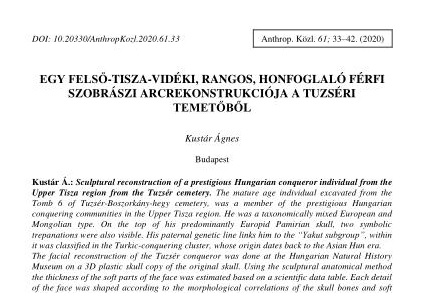Felső-Tisza-vidéki, rangos, honfoglaló férfi szobrászi arcrekonstrukciója a tuzséri temetőből
Absztrakt
The mature age individual excavated from the Tomb 6 of Tuzsér-Boszorkány-hegy cemetery, was a member of the prestigious Hungarian conquering communities in the Upper Tisza region. He was a taxonomically mixed European and Mongolian type. On the top of his predominantly Europid Pamirian skull, two symbolic trepanations were also visible. His paternal genetic line links him to the “Yakut subgroup”, within it was classified in the Turkic-conquering cluster, whose origin dates back to the Asian Hun era.
The facial reconstruction of the Tuzsér conqueror was done at the Hungarian Natural History Museum on a 3D plastic skull copy of the original skull. Using the sculptural anatomical method the thickness of the soft parts of the face was estimated based on a scientific data table. Each detail of the face was shaped according to the morphological correlations of the skull bones and soft tissues. The reconstructed facial features have a predominantly Europid appearance, but also faithfully reflect the mixed, Europid and Mongolian characteristics of the skull.
Hivatkozások
Éry, K. (1977): Embertani adatok a Felső-Tiszavidék X. századi népességéhez. Anthrop. Közl., 21: 15–30.
Éry, K. (1982): Újabb összehasonlító statisztikai vizsgálatok a Kárpát-medence 6–12. századi népességeinek embertanához. VMMK, 16: 35–85.
Fóthi, E. (2014): A Kárpát-medence 6–11. századi történetének embertani vonatkozásai. In: Sudár, B., Szentpéteri, J., Petkes, Z., Lezsák, G., Zsidai, Zs. (Szerk.) Magyar őstörténet, Tudomány és hagyományőrzés. MTA Bölcsészettudományi Kutatóközpont, Budapest. pp. 151–168.
Fóthi, E., Gonzalez, A., Fehér, T., Gugora, A., Fóthi, Á., Bíró, O., Keyser, C. (2020): Genetic analysis of male Hungarian conquerors: European and Asian paternal lineages of the conquering Hungarian tribes. Archaeol. Anthropol. Sci., 12: 31. DOI: 10.1007/s12520-019-00996-0
Geraszimov, M.M. (1949): Bases of the facial reconstruction. Nauka, Moscow.
Geraszimov, M.M. (1971): The face finder. Hutchinson and Co, London.
Ilumäe, A.M., Reidla, M., Chukhryaeva, M., Järve, M., Post, H., Karmin, M., Saag, L., Agdzhoyan, A., Kushniarevich, A., Litvinov, S., Ekomasova, N., Tambets, K., Metspalu, E., Khusainova, R., Yunusbayev, B., Khusnutdinova, E.K., Osipova, L.P., Fedorova, S., Utevska, O., Koshel, S., Balanovska, E., Behar, D.M., Balanovsky, O., Kivisild, T., Underhill, P.A., Villems, R., Rootsi, S. (2016): Human Y chromosome haplogroup N: A non-trivial time-resolved phylogeography that cuts across language families. Am. J. Hum. Genet., 99: 163–173. DOI: 10.1016/j.ajhg.2016.05.025
Jósa, A. (1900): Emlékek a honfoglalás korából. Arch. Ért., 20: 214–224.
Kustár, Á. (2003): Harta-Freifelt lelőhelyről származó honfoglaló magyar nő (15. sír) és férfi (22. sír) arcrekonstrukciója. MTM Arcrekonstrukciós katalógus. http://www.nhmus.hu/hu/arcreko_katalog
Kustár Á. (2005): Humán morfológiai variációk az arcon és a koponyán. A koponya és az arc morfológiai összefüggéseinek alkalmazása a plasztikus arcrekonstrukcióban. Anthrop. Közl. 46; 67–74.
Kustár, Á., Árpás, K. (2008): Facial reconstructions of the 18th Century mummies from Vác, Hungary. In: Atoche Pena, P., Rodriguez, M.C., Ramirez Rodriguez, M.A. (Eds) Mummies and science. World Mummies Rresearch. Proc. VIth World Congress on Mummy Studies. Academia Canaria de la Historia Ayuntamiento de Teguise, Santa Cruz de Tenerife. pp. 487–495.
Kustár, Á., Skultéty, Gy. (1996): A benepusztai honfoglaláskori férfi koponyarekonstrukciója. Savaria, 22(3): 179–190.
Lipták, P. (1957): Awaren und Magyaren im Donau-Theiss Zwischenstromgebiet. Acta Arch. Hung., 8: 199–259.
Nemeskéri, J., Éry, К., Kralovánszky, А. (1960): A magyarországi jelképes trepanáció. Anthrop. Közl., 4: 3–32.
Neparáczki, E., Maróti, Z., Kalmár, T., Kocsy, K., Maár, K., Bihari, P., Nagy, I., Fóthi, E., Pap, I., Kustár, Á., Pálfi, G., Raskó, I., Zink, A., Török, T. (2018): Mitogenomic data indicate admixture components of Central-Inner Asian and Srubnaya origin in the conquering Hungarians. PLoS One, 13(11): e0208295. DOI: 10.1371/journal.pone.0208295
N. Nepper, I., Révész, L. (1990): Etelközből a Kárpát-medencéig. A honfoglalók legújabb leletei. Kiállítási katalógus. A Déri Múzeum és a Herman Ottó Múzeum kiállítása. Déri Múzeum – Herman Ottó Múzeum, Debrecen.
Prag, J., Neave, R. (1997): Making faces. Using forensic and archaeological evidence. The Trustees of the British Museum. British Museum Press, London.
Révész, L. (1996a): „Őseinket felhozád…” In: Fodor, I. (Szerk.) A honfoglaló magyarság. Kiállítási katalógus. Magyar Nemzeti Múzeum, Budapest.
Révész, L. (1996b): A karosi honfoglaláskori temetők. Régészeti adatok a Felső-Tisza vidék X. századi történetéhez. Magyarország honfoglaláskori és Árpád-kori leletei I. Herman Ottó Múzeum – Magyar Nemzeti Múzeum, Miskolc.
Röhrer-Ertl, O., Helmer, R. (1984): Zu Stand und Möglichkeiten der Erneut modifizierten Kollmann-Methode. Gegenbaurs Morph. Jahrb., 130: 369–396.
Sjøvold, T. (1981): Árpás anatomical method for face reconstruction. Ossa, 7: 203–204.
Sobotta, J. (1990): Atlas of Human Anatomy. Urban & Schwarzenberg, Munich.
Taylor, K.T. (2001): Forensic Art and Illustration. CRC Press Boca Raton, London, New York, Washington D.C.




